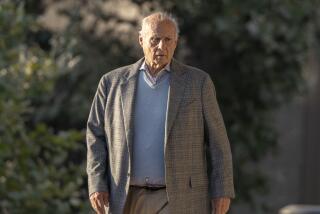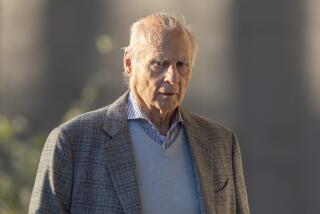Judges’ Role in Cruise Sponsored by Lawyer’s Group Raises Questions
In a stunning legal coup last year, Los Angeles trial lawyer Thomas V. Girardi and his frequent litigation colleague Walter J. Lack won a $333-million settlement from Pacific Gas and Electric Co. in a toxic pollution case.
For Girardi, one of the nation’s most successful trial attorneys, this was only one of many triumphs.
Girardi, 58, the president-elect of the American Board of Trial Advocates, has won verdicts or settlements in excess of $1 million more than 100 times in a career of more than three decades.
Much of his work is in the burgeoning field of lawsuits that challenge the dumping of toxic pollutants.
In the PG&E; case, Girardi and Lack pocketed a legal fee of at least $120 million; the rest of the settlement went to 650 plaintiffs in the desert town of Hinkley, Calif., near Barstow, where the water supply was found to have been contaminated by leaky PG&E; dumps of chromium.
In a world of growing legal acrimony and defensiveness, Girardi wins points for civility and an uncommon ability to cut through the kind of jargon that leaves many jurors’ eyes glazed.
San Francisco trial attorney Joseph Cotchett calls him “the most streetwise man I’ve ever met. He can take a complex set of facts and reduce it to a highly understandable situation for a jury. The average jury loves Tom Girardi because he doesn’t talk like a lawyer. . . . He’s not a great reader of legal books, either, but in front of a jury, he is dynamite.”
Girardi’s reputation as an influential member of the legal system was on display recently when several lawyers and judges assailed him for allegedly trying to curry undue favor with judges.
The criticism stemmed from Girardi’s Foundation for the Enrichment of the Law, which he said he and Lack created to give some of their substantial earnings back to the legal system.
First, the foundation contributed $1.2 million to refurbish and expand the jury facilities at the county’s downtown civil court complex at 1st and Hill streets.
Then, through the foundation, Girardi and Lack spent $350,000 to charter the Cunard cruise liner Sea Goddess II, to take 90 family members and friends in the legal and medical professions--including 10 active and retired judges--on a seven-day voyage in August in the Mediterranean Sea.
Girardi said eight of the 10 judges paid their own way on the cruise, and the lawyers and doctors who went were expected to reimburse the foundation with contributions.
Seven of the eight paying judges confirmed that they had paid for the trip. One, asking not to be identified, initially said he understood that it was a free trip but later said that he would pay.
What created the most controversy was the fact that among those on the trip were three of the five retired judges--Jack Tenner, John Trotter and Jack Goertzen--who had served on arbitration or mediation panels in the PG&E; case. All, according to Girardi and their own statements, had paid before the cruise, or would pay in the near future.
Two federal district judges from Los Angeles who did get a free cruise--Dickran Tevrizian and Ronald Lew--delivered lectures on the trip. They had a letter from a federal circuit judge in Washington who serves as chairman of the Committee on Codes of Conduct for the U.S. Judicial Conference saying that it was proper for them to accept the $3,070 cruise in exchange for lecturing.
Tevrizian said he had been a friend of Girardi since high school, but has usually avoided involvement in the lawyer’s cases. He said he had disclosed their friendship in one settlement agreed to by both parties in one case.
Another judge who went on the cruise, Coleman Swart, supervising Superior Court judge in Pasadena, said: “Tom is a personal friend. I never hear any of his cases, never have.” Swart said he paid his own way.
Four legal ethics professors from a variety of universities consulted by The Times said there was nothing improper about the cruise as long as the other judges paid their way, disclosed the trip to future litigants if Girardi was involved--and the cruise was not to celebrate the PG&E; settlement.
Several lawyers and judges, some of them prominent figures in Los Angeles’ legal community, criticized the trip, complaining that it symbolized Girardi’s acquisition of too much influence over the legal system. But all of them spoke only on the condition of anonymity.
Girardi denied that the cruise was a celebration of the PG&E; case, another phase of which is still being heard in Los Angeles County Superior Court.
He stressed that the purpose of the cruise--which left Monte Carlo and stopped at Portofino, Sardinia, Sorrento, Capri, and Taormina, Sicily, before returning to Monte Carlo--had included “an extensive professional program.”
One of Tevrizian’s lectures was titled, “What to Do When Your Corporate Client Becomes the Focus of a Criminal Investigation.”
Since the PG&E; settlement, which was announced in mid-1996, “we’ve had five big verdicts or settlements, so this wasn’t a celebration of that,” Girardi said.
Like most trial lawyers, Girardi is an exponent of the contingency fee system in which a lawyer bears all the costs of the litigation and charges no fees to the plaintiffs unless and until a verdict or settlement is obtained. Then the fees often run between 33% and 40%.
He says that if he had his way, all civil cases would be conducted on this basis, making it much more feasible for citizens who are not well-to-do to sue for damages.
Several of those showing up on the passenger manifest of the Sea Goddess II cruise have been expert witnesses in a number of recent Girardi and Lack toxic cases, resulting in settlements with Exxon and Lockheed, among other defendants.
A common thread running through these cases has been allegations that large corporations negligently allowed contaminants to enter into water or other supplies used by the plaintiffs, subjecting them to cancer and other diseases.
Most recently, Girardi filed suit against the Jet Propulsion Laboratory in Pasadena for allegedly causing cancer in dozens of local residents through faulty chemical disposal practices. The JPL denies the charges.
In a recent setback, Girardi was the lead lawyer in a class-action suit against the movie industry over accounting practices that allegedly understated profits. The suit lost in a lower court and is now on appeal.
Born in Denver in 1939, Girardi grew up in the Westchester neighborhood of Los Angeles and graduated from what is known now as Loyola-Marymount University and Loyola Law School. He also has a master’s degree in law from New York University.
He opened a solo practice in Los Angeles and won his first sizable verdict, for $65,000, in 1965. In 1971, he won a medical malpractice verdict of $1.4 million, the largest malpractice verdict in the state at the time.
The foundation that he and Lack created, and which Girardi says he controls, has also made a $2.4-million gift to Loyola Law School, payable at $400,000 a year for six years.
Girardi, an adjunct professor of law at Loyola Law School, where he teaches medical-legal law, trial practices and trial-lawyer ethics, is married and has three children by a previous marriage.
Even his critics are grudgingly impressed by his persuasiveness.
When a reporter relayed Girardi’s explanation for the ethics of the recent cruise to a lawyer for a corporation that Girardi is suing, the exasperated attorney said: “You mean, he is so powerful, he can get away with that!”
*
Times Rome bureau researcher Maria de Cristofaro contributed to this story.
More to Read
Get the L.A. Times Politics newsletter
Deeply reported insights into legislation, politics and policy from Sacramento, Washington and beyond. In your inbox three times per week.
You may occasionally receive promotional content from the Los Angeles Times.










